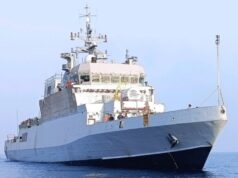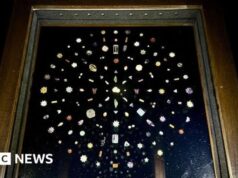By Colonel Awadhesh Kumar, Veteran Special forces
Submarine arm of the Indian Navy was established on 08 December 1967 with hoisting of the Indian Naval Ensign on INS KALVARI at St Petersburg. The long wait is finally over with commissioning of our own INS KALVARI constructed by Mazagaon Dock at Mumbai. The Commissioning has been done by PM Modi on 14 Dec 2017. INS KHANDERI presently undergoing rigorous pre commissioning trials will follow suit. Later KARANJ, KARSURA and two more will be adding up to a total of 6 x Scorpene submarines. Need of the hour is to place a repeat order of three more of these on Mazagaon and another three on DCNS of France with condition of making it in India. This will ensure that by 2025 we have 12 x Scorpene subs patrolling the Indian Ocean, keeping an eye on the Chinese Naval activity. In addition by that time we should be getting around other two or three submarines from our Project 75 (I). Also out of the present Kilos/Type 209 at least eight will still be soldiering on. The above will ensure full complements under Flag Officer Commanding Submarine West and FOCS East, mid-way to having FOCS South and FOCS Andaman.
Also a few days back` the second Indian nuclear Submarine joined its sister submarine. Soon INS ARIGHAT will be prowling the depths of Bay of Bengal and testing the depths of the Indian Ocean. It will be putting fears of assured retaliatory launch of nuclear tipped ballistic missiles on any adversary trying to harm India.
Last month on 19 November, Raksha Mantri Nirmala Sitharaman launched the second Submarine at the Ship Building Centre in Vishakhapatnam without any fanfare. The traditional coconut was broken and the Submarine entered the water. In the foreseeable future it will quietly proceed to its operational station somewhere in the Bay of Bengal.
It’s been eight long years when in 2009 the secret Advanced Technology Vessel project finally fructified with launch of INS ARIHANT. Thus what was conceived in 1974 finally fructified after nearly 35 years. Now we do need to move at a much faster pace. Much before 2030 we must deploy one SSBN Squadron each on East Coast and the West Coast,with each Squadron comprising three submarines each. Only with such numbers it can be ensured that at any given time each of these two Squadrons have one SSBN fully deployed at its designated operational station. Then one SSBN of each Squadron will be in transit to base and one SSBN of each Squadron will be undergoing rest/repairs/refit etc. The final aim must be to deploy two more squadrons, one each on the Southern Coast and Andaman Coast. This means 12 x SSBNs translating into 4xSSBNs deployed all the time as third leg of the nuclear triad.
From the details available both INS ARIHANT and INS ARIGHAT displace around 7000 tons and carry 12 × ballistic missiles carrying nuclear warhead each with range of 750 km. Soon these missiles would be replaced with K4 missiles having a range of 3500 km. Progressively there would be K5 with a range of 5000km and K6 with multiple warheads and a range up to 8000Km. However these two subs will be able to carry only 4 such missiles each.
Thus it is obvious that to target all the major cities/ industrial centres / major military bases of our adversaries existing or potential, we will need a very large numbers of SSBNs if they carry just four K5 or K6 missiles each. Therefore with increase in capability of designing and constructing submarine nuclear reactors, the next two submarines to be launched will be displacing around 8000 tons. Their bigger size will enable them to carry 8 missiles each instead of present four. These submarines, fitted with eight ballistic missiles or twice the Arihant’s missile load, should be joining the Navy by 2022. The ATV project to construct four SSBNs is India’s largest defence programme, estimated at Rs 90,000 crore. The cost of facilities erected by the Bhabha Atomic Research Centre to build the miniature nuclear powered research reactors and the Defence Research and Development Organisation facilities to build the submarine launched ballistic missiles are in addition.
This year is being celebrated as the Golden Jubilee Year of the Submarines. The project to construct 6 x Nuclear SSNs have already kicked off. As per news India is also negotiating with Russia to lease two more SSNs to augment the lone INS CHAKRA. After all the aim should be to have 24 of these patrolling the Indian Ocean. By now the nuclear submarine programme is also looking into designing a new 13000 ton SSBN type to give true ICBM capability at par with USA, Russia and China. The ATV programme has now nearly doubled in size to Rs 60,000 crore project.
Admiral Sunil Lanba recently told the media about the commencement of the SSN project. “It is a classified project? the process has started.” Design work for the indigenous SSNs displacing around 6,000 tonnes is under way at a newly constructed submarine design centre in Gurgaon. SSNs are armed with conventional cruise missiles and torpedoes but powered by nuclear reactors. They have excellent underwater speed` and endurance is subject to endurance of the crew. As they need not surface for periodic charging of batteries like the conventional submarines? Thus their endurance is limited to food stock being carried and the human endurance of being cooped in a small space.
Even the Project Varsha, a nuclear submarine base is progressing well and should be completed` by 2022. The base will house India’s SSBN/SSN fleet in concrete pens blasted out of the hills at Rambilli 50 km south of Vishakhapatnam. The total` cost of Project Varsha is itself Rs 30,000 crores. Soon we also have to look for a similar type of base facilities at or near INS KADAMBA.
Our Submarine projects are not in isolation or not to appoint more Flag Officers Submarines but to ensure that India is able to counter the growing Chinese submarine fleet of 54x Conventional subs, 4xSSBNs and 5xSSNs a total of 63 presently. China recently also sold eight conventionally powered diesel-electric submarines to Pakistan, at least some of which are likely to carry missiles may be even nuclear tipped.
As per Admiral Raja Menon “ Sea-based deterrents are going to become more important as time passes, especially for a country with a no-first use policy. The location of your nuclear weapons becomes known and even a half per cent knowledge of your existing weapon sites each year could add up to something substantial over the years, thus degrading your deterrent.”
With all these progress on the Submarine front, one of the happiest man would have been my uncle Late Commander Satish Kumar Singh, VSM. As a young Lt he had been a founder member of the Submarine Arm starting way back in 1961. He was part of a very small team of officers who had gone to UK for Sub training. Later he went to USSR and was part of the Commissioning crew of INS KALVARI in 1967..50 years ago.





